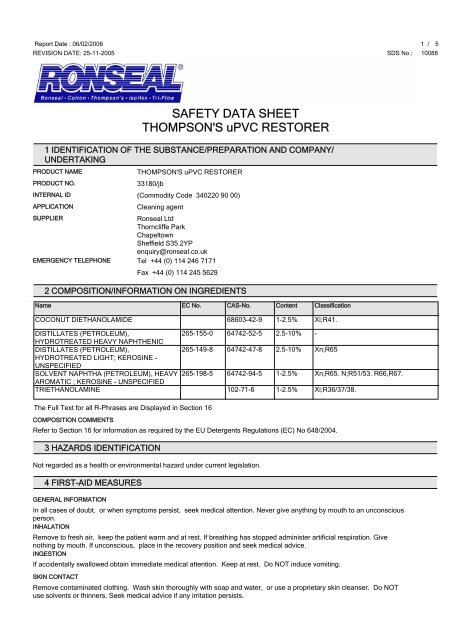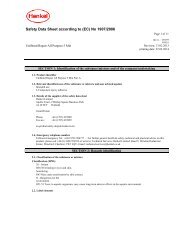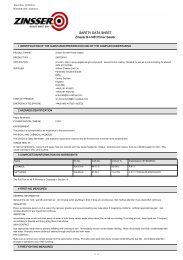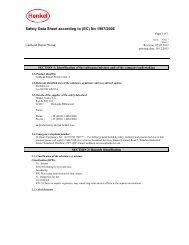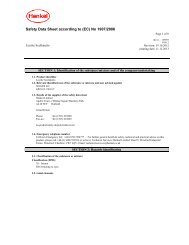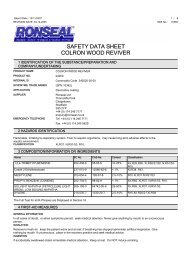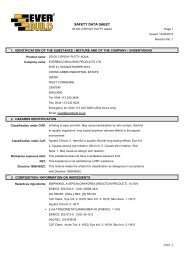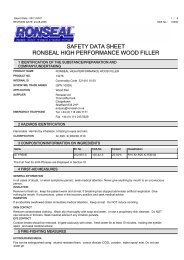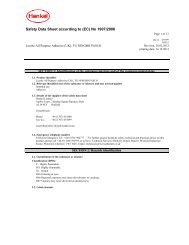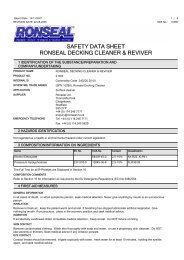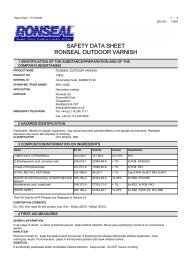SAFETY DATA SHEET THOMPSON'S uPVC RESTORER - Toolbank
SAFETY DATA SHEET THOMPSON'S uPVC RESTORER - Toolbank
SAFETY DATA SHEET THOMPSON'S uPVC RESTORER - Toolbank
Create successful ePaper yourself
Turn your PDF publications into a flip-book with our unique Google optimized e-Paper software.
Report Date : 06/02/2006 1 / 5REVISION DATE: 25-11-2005 SDS No.: 10088<strong>SAFETY</strong> <strong>DATA</strong> <strong>SHEET</strong><strong>THOMPSON'S</strong> <strong>uPVC</strong> <strong>RESTORER</strong>1 IDENTIFICATION OF THE SUBSTANCE/PREPARATION AND COMPANY/UNDERTAKINGPRODUCT NAMEPRODUCT NO.<strong>THOMPSON'S</strong> <strong>uPVC</strong> <strong>RESTORER</strong>33180/jbINTERNAL ID (Commodity Code 340220 90 00)APPLICATIONCleaning agentSUPPLIERRonseal LtdThorncliffe ParkChapeltownSheffield S35 2YPenquiry@ronseal.co.ukEMERGENCY TELEPHONE Tel +44 (0) 114 246 7171Fax +44 (0) 114 245 56292 COMPOSITION/INFORMATION ON INGREDIENTSNameEC No.CAS-No.ContentClassificationCOCONUT DIETHANOLAMIDE68603-42-9 1-2.5%Xi;R41.DISTILLATES (PETROLEUM),HYDROTREATED HEAVY NAPHTHENICDISTILLATES (PETROLEUM),HYDROTREATED LIGHT; KEROSINE -UNSPECIFIEDSOLVENT NAPHTHA (PETROLEUM), HEAVYAROMATIC ; KEROSINE - UNSPECIFIEDTRIETHANOLAMINE265-155-0265-149-8265-198-564742-52-5 2.5-10%64742-47-8 2.5-10%64742-94-5 1-2.5%102-71-6 1-2.5%-Xn;R65Xn;R65. N;R51/53. R66,R67.Xi;R36/37/38.The Full Text for all R-Phrases are Displayed in Section 16COMPOSITION COMMENTSRefer to Section 16 for information as required by the EU Detergents Regulations (EC) No 648/2004.3 HAZARDS IDENTIFICATIONNot regarded as a health or environmental hazard under current legislation.4 FIRST-AID MEASURESGENERAL INFORMATIONIn all cases of doubt, or when symptoms persist, seek medical attention. Never give anything by mouth to an unconsciousperson.INHALATIONRemove to fresh air, keep the patient warm and at rest. If breathing has stopped administer artificial respiration. Givenothing by mouth. If unconscious, place in the recovery position and seek medical advice.INGESTIONIf accidentally swallowed obtain immediate medical attention. Keep at rest. Do NOT induce vomiting.SKIN CONTACTRemove contaminated clothing. Wash skin thoroughly with soap and water, or use a proprietary skin cleanser. Do NOTuse solvents or thinners. Seek medical advice if any irritation persists.
Report Date : 06/02/2006 2 / 5REVISION DATE: 25-11-2005 SDS No.: 10088<strong>THOMPSON'S</strong> <strong>uPVC</strong> <strong>RESTORER</strong>EYE CONTACTContact lenses should be removed. Irrigate copiously with clean, fresh water for at least 10 minutes, holding the eyelidsapart, and seek medical advice.5 FIRE-FIGHTING MEASURESEXTINGUISHING MEDIAThis product is not flammable. Fire can be extinguished using: alcohol resistant foam, carbon dioxide (CO2), powder,water spray/ mist. Do not use water jet.SPECIAL FIRE FIGHTING PROCEDURESAs the product contains combustible organic components, fire will produce dense black smoke containing hazardous ofcombustion (see Section 10). Exposure to decomposition products may be hazardous to health. Appropriate selfcontainedbreathing apparatus may be required. Cool closed containers exposed to fire with water spray. Do not allow runofffrom fire fighting to enter drains or watercourses.6 ACCIDENTAL RELEASE MEASURESSPILL CLEAN UP METHODSExclude sources of ignition and ventilate the area. Exclude non-essential personnel. Refer to protective measures listed inSection 7 and 8. Contain and collect spillage with non-combustible absorbent materials, e.g. sand, earth or vermiculite,and place in a suitable container for disposal in accordance with the waste regulations (see Section 13). Clean preferablywith a detergent; avoid the use of solvents. If the product enters drains or sewers, immediately contact the local watercompany; in the case of contamination of streams, rivers or lakes, the relevant environment agency.7 HANDLING AND STORAGEUSAGE PRECAUTIONSKeep away from heat, sparks and open flame. Smoking, eating and drinking should be prohibited in areas of storage anduse. Avoid skin and eye contact. Provide good ventilation. Avoid inhalation of vapour. Avoid inhalation of dust.For Occupational Exposure Controls, refer to Section 8.The Manual Handling Operations Regulations may apply to the handling of containers/packages of this product.STORAGE PRECAUTIONSObserve the label precautions. Store between 5°C and 25°C. Keep in a cool, dry, well ventilated place, away fromsources of heat, ignition and direct sunlight. No smoking.The principles contained in the HSE Guidance Note: Storage of Packaged Dangerous Substances, should be observedwhen storing this product.To avoid the risk of spillage, always store and transport in a secure and upright position.8 EXPOSURE CONTROLS/PERSONAL PROTECTIONNameDISTILLATES (PETROLEUM),HYDROTREATED LIGHT; KEROSINE -UNSPECIFIEDDISTILLATES (PETROLEUM),HYDROTREATED HEAVY NAPHTHENICTRIETHANOLAMINECOCONUT DIETHANOLAMIDEStdLT - ppm LT - mg/m3 ST - ppm ST - mg/m3SUP 165 ppm 1200 mg/m3 No std. No std.5 mg/m3 10 mg/m3No std. No std. No std. No std.No std. No std. No std. No std.SOLVENT NAPHTHA (PETROLEUM), HEAVYAROMATIC ; KEROSINE - UNSPECIFIEDINGREDIENT COMMENTSWEL = Workplace Exposure Limits SUP = Supplier's recommendation.ENGINEERING MEASURESNo std. No std. No std. No std.Provide adequate ventilation. Where reasonably practicable, this should be achieved by the use of local exhaustventilation and good general extraction. If these are not sufficient to maintain concentrations of particulates and/or solventvapours below the relevant occupational exposure limits, suitable respiratory protective equipment should be worn.RESPIRATORY EQUIPMENTIf exposure to hazardous substances identified above cannot be controlled by the provision of local exhaust ventilation andgood general extraction, suitable respiratory protective equipment should be worn.
Report Date : 06/02/2006 3 / 5REVISION DATE: 25-11-2005 SDS No.: 10088<strong>THOMPSON'S</strong> <strong>uPVC</strong> <strong>RESTORER</strong>HAND PROTECTIONWhen skin exposure may occur, advice should be sought from glove suppliers on appropriate types. Barrier creams mayhelp to protect exposed areas of skin but are not substitutes for full physical protection. They should not be applied onceexposure has occurred.EYE PROTECTIONEye protection designed to protect against liquid splashes should be worn.OTHER PROTECTIONCotton or cotton/synthetic overalls or coveralls are normally suitable. Grossly contaminated clothing should be removedand the skin washed with soap and water or a proprietary skin cleaner.All personal protective equipment, including respiratory protective equipment, used to control exposure to hazardoussubstances must be selected to meet the requirements of the COSHH Regulations.9 PHYSICAL AND CHEMICAL PROPERTIESAPPEARANCECOLOURODOURSOLUBILITYLow viscosity liquid.Beige. to Light brownCharacteristic solvent type.Slightly soluble in water.FLASH POINT (°C) > 61 CC (Closed cup). VOLATILE ORGANIC COMPOUND (VOC)10 STABILITY AND REACTIVITY330 max g/litreSTABILITYStable if stored under recommended storage and handling conditions.CONDITIONS TO AVOIDKeep away from oxidising agents and strongly alkaline and strongly acidic materials.HAZARDOUS DECOMPOSITION PRODUCTSIn a fire, hazardous decomposition products such as smoke, carbon monoxide, carbon dioxide and alcohols may beproduced.11 TOXICOLOGICAL INFORMATIONTOXICOLOGICAL INFORMATIONThere is no data available on the product itself. The product has been assessed following the conventional method in CHIPand is classified for toxicological hazards accordingly. This takes into account, where known, delayed and immediateeffects and also chronic effects from components from short-term and long-term exposure by oral, inhalation and dermalroutes of exposure and eye contact. See Sections 3 and 15 for details of the resulting hazard classification.Exposure to organic solvent vapours in excess of the stated occupational exposure limit may result in adverse healtheffects such as irritation of the mucous membrane and the respiratory system and adverse effects on the kidney, liver andcentral nervous systems. Symptoms and signs include headache, dizziness, fatigue, muscular weakness, drowsinessand in extreme cases loss of consciousness.Solvents may cause some of the above effects by absorption through the skin.Repeated or prolonged contact with the product may lead to removal of natural fats from the skin resulting in non-allergiccontact dermatitis and absorption through the skin. Splashes in the eyes may cause irritation and reversible local damage.INGESTIONThis product contains an in-can biocide, may be harmful if swallowed.12 ECOLOGICAL INFORMATIONECOTOXICITYThe product has been assessed following the conventional method for CHIP and is not classified as dangerous for theenvironment, but contains substances so classified. See Section 2 for details.DEGRADABILITYThere is no data available on the product itself.ACUTE FISH TOXICITYThere is no data available on the product itself.
Report Date : 06/02/2006 4 / 5REVISION DATE: 25-11-2005 SDS No.: 10088<strong>THOMPSON'S</strong> <strong>uPVC</strong> <strong>RESTORER</strong>WATER HAZARD CLASSIFICATIONThere is no data available on the product itself. The product should not be allowed to enter drains or watercourses, or bedeposited where it can affect ground or surface waters.13 DISPOSAL CONSIDERATIONSDISPOSAL METHODSDo not allow into drains or watercourses, or dispose of where ground or surface waters may be affected. Wastes,including emptied containers, are controlled wastes and should be disposed of in accordance with regulations made underthe Control of Pollution Act and the Environmental Protection Act. Using information provided in this data sheet, adviceshould be obtained from the Waste Regulation Authority whether the Special Waste Regulations apply.14 TRANSPORT INFORMATIONGENERALUN NO. ROADUN NO. SEAThis product is not classified as dangerous for carriage.Transport within user's premises: always transport in closed containers that are upright andsecure. Ensure that person's transporting the product know what to do in an accident orspillage.N/CN/CADR CLASSNot dangerous according toADR.15 REGULATORY INFORMATIONRISK PHRASES<strong>SAFETY</strong> PHRASESUK REGULATORY REFERENCESNCS2S25S26S37S51Not classified.Keep out of the reach of childrenAvoid contact with eyes.In case of contact with eyes, rinse immediately with plenty of water and seekmedical advice.Wear suitable gloves.Use only in well-ventilated areas.The information contained in this safety data sheet does not constitute the user's own assessment of workplace risks asrequired by other health and safety legislation.The provisions of the Health and Safety at Work etc. Act and the Control of Substances Hazardous to Health Regulationsapply to the use of this product at work.The Manual Handling Operations RegulationsThe Chemicals (Hazard Information and Packaging for Supply) Regulations.The Carriage of Dangerous Goods and Use of Transportable Pressure Equipment Regulations.European Agreement concerning the International Carriage of Dangerous Goods by Road [ADR]EU DIRECTIVESDangerous Substance Directive 67/548/EEC. Dangerous Preparations Directive 1999/45/EEC. Safety Data Sheet Directive91/155 EC Detergents Regulations No 648/2004GUIDANCE NOTESWorkplace Exposure Limits EH40.16 OTHER INFORMATIONGENERAL INFORMATIONThe information contained in this safety data sheet is based on the present state of knowledge and current nationallegislation. It provides guidance on health, safety and environmental aspects of the product and should not be construedas any guarantee of technical performance or suitability for particular applications.
Report Date : 06/02/2006 5 / 5REVISION DATE: 25-11-2005 SDS No.: 10088<strong>THOMPSON'S</strong> <strong>uPVC</strong> <strong>RESTORER</strong>The product should not be used for purposes other than those shown in section 1 without first referring to the supplier andobtaining written handling instructions. As the specific conditions of use of the product are outside the supplier's control,the user is responsible for ensuring that the requirements of relevant legislation are complied with.Information shown on product label, as required by Annex VII A of the EC Detergents Regulations No. 648/2004/EU.Contains less than 5% non-ionic surfactantsContains 1, 3-bis(hydroxymethyl)-5, 5-dimethylimidazolidine-2, 4-dione [DMDM Hydantoin]Contains FormaldehydeFor specific guidance contact Ronseal Technical Services. [Helpline +44 (0) 114 240 9469 ] ; Email: enquiry@ronseal.co.ukREVISION COMMENTSRevised to meet the requirements of the Detergents Regulations (EC) No 648/2004.REVISION DATE 25-11-2005REV. NO./REPL. SDS111188/1GENERATEDSDS NO. 10088/0<strong>SAFETY</strong> <strong>DATA</strong> <strong>SHEET</strong> STATUSApproved.DATE 25-11-2005SIGNATURERISK PHRASES IN FULLNCR36/37/38R41R51/53R65R66R67Not classified.K. R. P. WinderIrritating to eyes, respiratory system and skin.Risk of serious damage to eyes.Toxic to aquatic organisms, may cause long-term adverse effects in the aquatic environment.Harmful: may cause lung damage if swallowed.Repeated exposure may cause skin dryness or cracking.Vapours may cause drowsiness and dizziness.DISCLAIMERInformation contained in this Safety Data Sheet is based on data considered to be accurate at the time of its preparation. Despite ourefforts, it may not be up to date or applicable to the circumstances of any particular case. ,The supplier accepts no responsibility whatsoever (except otherwise provided in law) for any damage or injury resulting fromabnormal use, from any failure to follow appropriate practices or from hazards inherent in the product.


